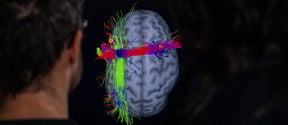Aalto at Slush: 12 ways we change the world
The Aalto stand is home to smart, sustainability-driven science.

A typical problem in teamwork is an imbalance in participation – a few team members are active but not everyone's voice is heard. The Visentools project uses visual tools and haptic feedback to make workshops and team meetings more participatory and meaningful. The project is funded by Business Finland and has been piloted since May.
‘The project was initially inspired by Legos, but we found them difficult to use, so we had to create physical objects that were more suited to the needs of working life. We also realised from the start that a quality meeting is well facilitated, but facilitators are also a limited resource. So, we created a digital facilitator, a mobile app that is always available in your pocket,’ says Professor Robin Gustafsson, who is leading the project.
The Visentools objects enable people to tell stories with visual metaphors. For example, strategy can be thought of as a compass, we can navigate stormy waters, aim toward a lighthouse, be agile like a tiger, have the memory of an elephant, make wise decisions like an owl, or move slowly and carefully like a snail. The objects can also be used in other ways, such as a tower standing in for a rocket standing for growth or bigger steps in the development.
‘The aim is to make it easier for people to communicate and express their ideas. The objects can help make sure that you’re understood correctly. Visentools has also been designed to support very diverse teams where communication can be challenging because of factors like language, hierarchy, or personality differences,’ says Thomas Tuominen, the project’s commercialisation manager.
Tuominen adds that ‘an object can be used several times to reinforce a memory trace. Humans have been telling stories and illustrating them with pictures forever. It's a natural way of remembering, and you can remember a story almost word for word.’

The objects used in Visentools also offer new ways to interact in a meeting. ‘For example, when you bring a goal or proposal to the table with an object, it becomes visually present, part of the common picture. It stays alive much more strongly than if it’s only expressed once out loud. It’s also better understood. Everyone's perspectives get taken into account as the group articulates its shared vision,’ says Gustafsson.
In addition to objects, Visentools supports collaborative design with an app that replaces flip charts, post it notes, computers, pens and paper. ‘Each participant has a gamified app on their mobile phone. It allows everyone to be involved in a collaborative process and has a clock ensures that a pre-agreed time is spent on each step,’ explains Gustafsson.
Tuominen adds that ‘the implementation has a mechanism to ensure everyone's participation. This way, even the quiet ones can have a voice.’
‘The software manages the meeting in a professional way, without any of the participants taking time to take notes or look at the clock,’ says Tuominen.
The result is a video story that pulls together what was agreed upon. The summary can be returned to at any time, shared and commented on.

The Visentools project is based on a systematic analysis of neuroscientific and psychological research on the processing of visually presented information. Gustafsson has also researched the promotion of playfulness in the workplace.
‘In the project, we interpret playfulness as fun, creative and relaxed. Gamification is an essential part of that,’ says Tuominen.
Visentools has been piloted by a dozen clients since May. The pilot projects have mainly tested whether people are comfortable working according to the application's instructions and how easily they start working with objects. During each pilot, the team learned many new things. ‘To our delight, work has always got off the ground without us having to intervene. And after each pilot, we have been agile in making the necessary changes,’ says Tuominen.
The Visentools team brings together solid expertise in many fields. Professor Masood Masoodian, postdoctoral researcher Mikko Illi and PhD researcher Agnese Bartolucci from Aalto University's Department of Art and Media bring visual expertise to the project. Neuroscience and psychology expertise come from Jaana Simola, a researcher in neuroscience and social psychology at the University of Helsinki, and Janina Saarnio, a project worker specialising in cognitive neuroscience. Juuso Heikkilä is responsible for project management, and Sneha Saj and Tom Railio for software development.
Visentools will be at Aalto's stand at Slush on 1 December 2023. Aalto will also showcase ambitious solutions to challenges in health and well-being, imaging, energy storage, sustainable design and nutrient recycling.


The Aalto stand is home to smart, sustainability-driven science.

Team plans expansion while adhering to circular economy principles

Aalto University researchers are developing a device that helps support sobriety in conjunction with other treatments, such as psychosocial treatments and pharmaceuticals.

Common neurological disorders like depression and chronic pain can be challenging to treat with conventional methods. An automated version of a long-used brain stimulation technique holds real promise as a reliable and effective drug-free alternative.



